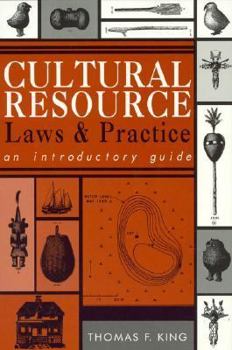Cultural Resource Laws and Practice: An Introductory Guide: An Introductory Guide
Select Format
Select Condition 
Book Overview
With its updated analysis and treatments of key topics, this new edition is a must-have for archaeologists and students, historic preservationists, tribal governments, and others working with cultural... This description may be from another edition of this product.
Format:Paperback
Language:English
ISBN:0761990445
ISBN13:9780761990444
Release Date:December 1998
Publisher:Altamira Press
Length:303 Pages
Weight:0.95 lbs.
Dimensions:0.7" x 6.1" x 9.0"
Related Subjects
Administrative Law Archaeology Architecture Business Constitutional Law Cultural Policy Education & Reference Historic Preservation Humanities Law Legal Self-Help Political Science Politics & Government Politics & Social Sciences Property Public Policy Social Science Social Sciences TextbooksCustomer Reviews
2 ratings
Essential Resource for Historic Preservation (2nd Edition)
Published by Thriftbooks.com User , 14 years ago
This is the second edition of _Cultural Resource Laws and Practice_, with revisions as of 2004. This title continues to be the best single resource for an overview of the complex world of historic preservation compliance process and legal authorities (laws, etc.). The 2004 edition (2nd edition) shows an increasing focus on environmental justice and expanding access for the variety of stakeholders, notably Native American tribes and other indigenous groups. This expansion and greater voice given to Native Peoples has created much controversy among the archaeological community. Some archaeologists embraced the changes and new opportunities for collaboration with tribes. Others felt the changes to be problematic for their customary ways of doing archaeology, especially when dealing with burials and other matters dealt with in NAGPRA. This controversy began long before the first passage of NAGPRA in 1990, and continues through the present (2009), almost 20 years as of this review. Thomas King has been a tireless advocate for a more inclusionary process, for both Native Americans and for other generally excluded public stakeholders in the U.S., and that has made him a controversial if not demonized figure in some archaeological and development circles. The second edition covers the following topics: PART ONE: BACKGROUND AND OVERVIEW 1. Introduction: The Voice of the People 2. A Brief History of U.S. Cultural Resource Management 3. The Players (Advisory Council, EPA, CEQ, Federal Agencies, NPS, SHPO, THPO, Applicants, etc.) PART TWO: LAW AND PRACTICE 4. The Umbrella: The National Environmental Policy Act (NEPA) 5. Impacts on Historic Properties: Section 106 of the National Historic Preservation Act (NHPA) 6. Other Cultural Resource Authorities (NAGPRA, Native American Religious Practices- AIRFA, Executive Order 13007, Environmental Justice- EO 12898, Social Impact Statements, Landscapes, Archaeology, Historic Documents, Shipwrecks, and more) PART THREE: BRINGING IT ALL TOGETHER 7. Comprehensive Cultural Resource Impact Assessment 8. Cultural Resource Management Plans 9. The Future End matter includes a Bibliography, some Internet sites (as of 2004), Acronyms, Abbreviations and Terms, Definitions, Laws, Executive Orders, and Regulations, a model Section 106 Memorandum of Agreement, a model NAGPRA Plan of Action, and index. This is a fantastic resource I referred to often in my time in historic preservation. It offers the broadest point of view under historic preservation principles and practices, and especially as indicated in the letter and spirit of the law. One of the most important aspects of the book is how King shows the reasoning and process in numerous examples. It, or the latest edition of the book, should be an essential resource on the shelf of every historic preservation specialist (archaeologists, architects, archivists, landscape architects, historians, etc.), tribal officer, development corporation, resource managers and attorneys,
I was dreading this book...
Published by Thriftbooks.com User , 20 years ago
I was dreading this book. It was required for a class in CRM law, but I have now decided that it is an essential reference that will always be found on a handy shelf in my office.King is recognized as a leader in the field of federal cultural resource management and has written a comprehensive, digestible overview of the history of the subject and the laws that govern archaeology on federally-funded projects. The chapters are informative, yet to the point, opinionated, and, dare I say, actually funny! King gives bibliographic references to most case studies, in case you'd like to chase down the details behind a certain cultural resource management decision, but it is also the perfect, readable beginner's guide to the history and development of CRM law.The one critique I have is that it may be time to do an update of the book to reflect the ways that CRM law has changed since 1998. However, the fundamental concepts and laws are still the same, and the book remains the best on the subject. Today, I'm buying his newest book "Thinking About Cultural Resource Management: Essays from the Edge" (2002) to see what else King has to say. I will definitely seek out other books by the author.




